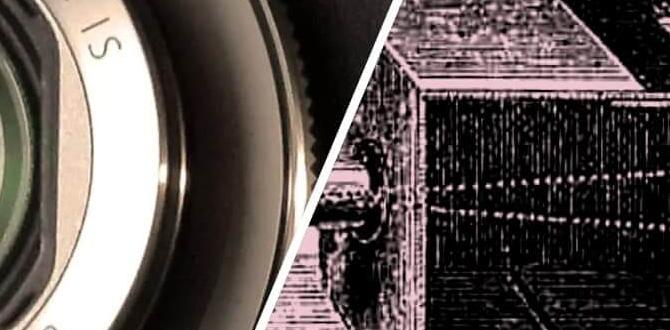Have you ever wondered who invented the LED light bulb? It’s a small device that changed how we see the world around us. Before this invention, we relied heavily on bulbs that drained energy and often burned out quickly. Imagine a world without bright, energy-efficient lights!
The story of the LED light bulb is fascinating and filled with innovation. Many people dream of creating something that helps others. But not everyone gets to see their dream come true. One inventor took on the challenge of making light safer and longer-lasting.
Did you know that the first LED light was born in the 1960s? This invention was just the beginning. Over the years, improvements paved the way for brighter and better bulbs.
So, who deserves the credit for bringing us this brilliant idea? Let’s dive into the history of the LED light bulb and explore the brilliant minds behind it!
Who Invented The Led Light Bulb? Discover Its Innovators! The Development Of The Led (Light Emitting Diode) Light Bulb Is A Fascinating Journey That Intertwines The Contributions Of Various Scientists And Inventors Over Several Decades. This Article Will Delve Into The Origins Of Led Technology, Key Figures Behind Its Invention, And The Evolution Of Led Light Bulbs Into The Energy-Efficient Lighting Solution We Know Today. The Birth Of Led Technology The Foundation Of Led Technology Dates Back To The Early 20Th Century. In 1907, Henry Round, An Engineer Working For Marconi Labs, Discovered That Certain Materials Emitted Light When An Electric Current Passed Through Them. However, It Wasn’T Until The 1960S That Significant Advancements Were Made In Led Development. Key Innovators In Led Invention 1. **Nick Holonyak Jr.**: Often Referred To As The Father Of The Led, Holonyak Was The First To Create A Visible-Spectrum Led In 1962 While Working At General Electric. His Red Led Revolutionized The Industry, Paving The Way For Further Advancements In Led Technology. 2. **M. George Craford**: A Former Student Of Holonyak, Craford Made Significant Breakthroughs At Monsanto, Developing The First Yellow Led In 1972 And Improving Red And Orange Leds’ Efficiency. 3. **Shuji Nakamura**: In The 1990S, Nakamura Invented Blue Leds, Which Opened The Doors For The Creation Of White Led Light Bulbs By Combining Red, Green, And Blue Light. His Work Earned Him The Nobel Prize In Physics In 2014, Solidifying His Place As A Crucial Figure In Led Innovation. The Evolution Of Led Light Bulbs The Introduction Of White Led Light Bulbs Has Transformed How We Approach Energy-Efficient Lighting. These Bulbs Offer Numerous Benefits Over Traditional Incandescent And Fluorescent Lights, Including Longer Lifespan, Lower Energy Consumption, And Minimal Heat Production. Conclusion The Invention Of The Led Light Bulb Is A Remarkable Tale Of Creative Minds Pushing The Boundaries Of Technology. From Henry Round’S Early Discoveries To The Groundbreaking Work Of Nick Holonyak Jr., M. George Craford, And Shuji Nakamura, The Evolution Of Led Lights Has Changed The Way We Illuminate Our Lives While Contributing Significantly To Energy Conservation Efforts. Understanding Who Invented The Led Light Bulb Gives Us Insight Into The Innovative Spirit That Drives Technological Advancement In Lighting Solutions Today.

Who Invented the LED Light Bulb
The LED light bulb has a fascinating history. It was invented by Nick Holonyak Jr. in 1962. This bright idea came from his work at General Electric. Holonyak wanted to create a better and more efficient light source. Did you know that LED bulbs use less energy than traditional bulbs? Today, they can last for years! Understanding this invention helps us appreciate modern lighting and energy-saving options.
What is an LED Light Bulb?
Explanation of Light Emitting Diodes (LED) technology. Advantages of LED over traditional light bulbs.
An LED bulb is a super cool light that uses tiny Light Emitting Diodes (LEDs) to shine bright. Unlike old bulbs that get hot and waste energy, LED lights are like the superheroes of the lighting world—they save energy and last a long time! Did you know that they use up to 80% less energy? That’s like saving enough power to light up a whole street! Plus, they come in all shapes and colors, brightening our days and nights without burning out like that one pair of socks you forgot in the dryer.
| Feature | Traditional Bulbs | LED Bulbs |
|---|---|---|
| Energy Consumption | High | Low |
| Lifetime | 1,000 hours | 25,000+ hours |
| Heat Emission | High | Low |
| Color Options | Limited | Varied |
Commercialization of LED Light Bulbs
Timeline of LED light bulb commercialization. Notable companies and their contributions to bringing LEDs to the consumer market.
The journey of turning LEDs into household names didn’t happen overnight. In the 1960s, a scientist named Nick Holonyak created the first visible LED. Fast forward to the 1990s, and companies like Philips and Cree jumped in, making LEDs bright and colorful. By the early 2000s, these nifty lights began to light up homes and streets. Today, LED light bulbs are everywhere, saving energy and money. Who knew saving the planet could look so cool?
| Year | Event | Company |
|---|---|---|
| 1962 | First visible LED created | General Electric |
| 1990 | Commercial LEDs introduced | Philips |
| 2000 | Widespread consumer use | Cree |
| 2010 | LEDs dominate lighting market | Osram |
Impact of LED Light Bulbs on Energy Efficiency
Statistics on energy savings and efficiency compared to incandescent bulbs. Environmental benefits associated with the adoption of LED lighting.
Switching to LED light bulbs saves a lot of energy. In fact, they are about 80% more efficient than old incandescent bulbs. This change means less power is needed to light our homes. LEDs also last much longer. They can last up to 25,000 hours! This saves money on replacements.
Using LED bulbs is good for the environment too. It helps reduce carbon emissions. Fewer emissions lead to cleaner air. Here are some quick facts on the benefits:
- Less energy use reduces electricity bills.
- Longer lifespan means less waste.
- Lower energy consumption cuts down fossil fuel use.
Overall, LED lights make things brighter and better! They shine a light on a future with less waste and more savings.
What are the benefits of LED lighting?
LED lighting offers many benefits. It saves energy, lasts longer, and helps the environment. By using less power, we can lower our energy bills and help our planet.
Future Innovations in LED Technology
Emerging trends and advancements in LED technology. Potential future applications and impact on various industries.
The future of LED technology looks bright! New trends are shaping how we use lights. For example, smart LEDs can change colors and connect to the internet. This helps save energy and makes homes fun. Imagine lights that match your mood!
Many industries will benefit from these changes:
- Healthcare: LED lights can help with patient recovery.
- Transportation: Bright signals can improve road safety.
- Entertainment: Shows will offer more colorful experiences.
As LED technology grows, it will change our world in amazing ways.
What are the emerging trends in LED technology?
Some trends include smart lighting, which can adjust light levels automatically, and sustainable designs that use less energy. These innovations help reduce costs and environmental impact.
Conclusion
In conclusion, the LED light bulb was popularized by inventors like Nick Holonyak in the 1960s. These bulbs use less energy and last longer than traditional lights. You can help save energy and money by switching to LEDs in your home. For more fun facts about inventions, consider reading more about Nick Holonyak and other great inventors!
FAQs
What Year Was The First Practical Led Light Bulb Developed?
The first practical LED light bulb was developed in 1962. A scientist named Nick Holonyak, Jr. made it. He created a light that used less energy than regular bulbs. This was the start of better and brighter LED lights we use today.
Who Are The Key Inventors And Scientists Credited With The Development Of Led Technology?
The key inventors of LED technology are Nick Holonyak Jr., who created the first visible LED in 1962. Then there’s Hiroshi Amano and Shuji Nakamura, who helped make blue LEDs in the 1990s. Their work allowed us to have bright white lights today. These inventors changed how we use light in our homes and streets. We owe a lot to them for our colorful and energy-saving lights!
How Does The Technology Behind Led Light Bulbs Differ From Traditional Incandescent Bulbs?
LED light bulbs use a special material that makes light when electricity passes through it. This material is more efficient than the wires in traditional incandescent bulbs, which waste energy as heat. LEDs last much longer than incandescent bulbs, so you don’t have to change them as often. Plus, LEDs use less electricity, which helps save money on your bills!
What Are The Environmental Benefits Associated With Using Led Light Bulbs Compared To Other Lighting Technologies?
LED light bulbs help the environment in many ways. They use less energy than regular bulbs, so we save electricity. This means we burn less fossil fuel, which helps reduce pollution. LED bulbs also last a long time, so we throw away fewer old bulbs. Overall, using LEDs helps keep our planet cleaner and healthier for everyone.
In What Applications Have Led Light Bulbs Become Most Widely Used Since Their Invention?
LED light bulbs have become popular in many places. We use them at home for regular lighting. They are also used in streetlights to brighten roads. You can find them in cars for headlights and taillights. Even in electronic devices like TVs, LED lights help us see better!








